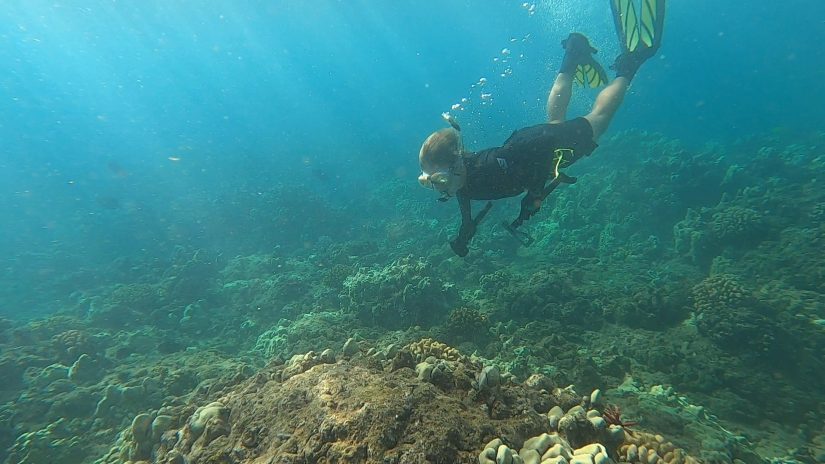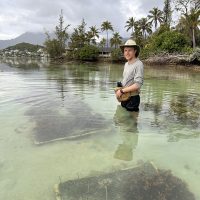Bleaching. This complicated and foreboding term now lurks around every conversation about coral reefs. Impacted heavily by climate change and associated warming oceans, coral reefs experience bleaching when the algae that live in their tissues and contribute vitally to their growth are expelled, causing the corals to lose their color, and possibly their lives.
Closely related to anemones and jellyfish, corals can obtain algae from the environment and put them in their tissues. “Corals live like a little diaphanous greenhouse, where the algae are safe and consume the waste products from coral. In exchange, the algae give oxygen, sugars, and other nutrients back to the coral animal,” Callum Backstrom, a PhD student at SAFS, describes. The mutualism between coral and algae allows corals, otherwise diminutive, gelatinous animals, to make the massive, multi-ton skeletal structures composing reefs. Home to about 25% of all marine life and hosting up to half of all marine fish at some point in their life cycle, coral reefs are incredibly important for humans too, reducing up to 85% of wave height and storm energy on the coastlines they border.

A member of Jacqueline Padilla-Gamiño’s lab group, Callum is interested in the resilience of certain corals to bleaching. “I’m asking questions like why are some corals more resilient? And for the ones that do survive, how could coral reproduction be compromised after a bleaching event?” Callum shared. A primary cause of bleaching is ocean warming, which causes the algae to go into “overdrive,” producing toxic forms of oxygen that in turn stress the coral into expelling their primary food source. Bleached corals may resorb their reproductive cells for nutrition and otherwise forego reproduction altogether to survive starvation until they can regain their photosynthetic algae.

More resilient corals that resist bleaching may contain strains of heat-tolerant algae, but, as Callum explains, there are issues associated with this: “When oceans are cooler and times are good, these resilient types of algae are not generally the best partners for the coral. They aren’t as efficient, or don’t provide as much energy to the coral as less resilient algal strains and therefore can cause the coral to be outcompeted by other coral colonies in their environment.” Another way that more resilient corals combat bleaching is by increasing their rate of feeding on zooplankton and detritus from the water column; however, more feeding could mean these corals are prone to consume more pollutants, such as microplastics and heavy metals, in the marine environment.
The effects of these pollutants are a specific area of interest for Callum: do bleached corals accumulate more pollutants from a less photosynthetic, more feeding-driven diet, and could these acquired pollutants damage the health or reproductive success of bleached corals well after recovery of their symbiotic algae?
Some pollutants, like microplastics, are synthetically produced by humans and therefore have a clear origin as environmental contaminants. One difficulty faced when asking questions about elemental contaminants like metals is that many metals are used in low concentrations as essential trace nutrients for healthy coral function. But most studies on this topic focus on vertebrates, and very little is known about contaminants in organisms without a backbone, such as corals. “So, a key piece of this puzzle is to find out what the normal concentrations are for corals, what kind of contaminants are building up and at what level, and is this happening when they’re stressed and eating more?” Callum said.

The breakdown in the symbiosis between corals and their algae helps to answer this question. Callum has extensively studied the mutualistic exchange of resources between corals and their algae – last year, he published his work investigating the role of photosynthesis in mesophotic corals from deep, almost pitch-black depths of the ocean in the Proceedings of the Royal Society.

This gave him a basis to hypothesize about how bleaching events can show us what is essential to that mutualism. “When a coral undergoes a bleaching event and dumps out all its algae, when it gets them back, the metals found in the newer algal cells could be the ones important for normal cell function, as opposed to lifelong contaminants. I have found that algal cells packed inside coral eggs prior to reproduction have different, often lower metal concentrations than those in the adult coral, which could corroborate a baseline level of “healthy,” essential trace levels of these metals. Everything else above these baselines, or that does not get transferred to the offspring, then has a much more compelling basis to be called a contaminant,” Callum explains. An example of an elevated metal that Callum has seen in the eggs of coral is arsenic. Used in herbicides in Hawaii’s agriculture, atomic pollutants such as arsenic don’t degrade, meaning arsenic released into the environment 100 years ago remains in the system. “And now we might be seeing it work its way through corals and other marine organisms,” Callum shares.
To study these issues, Callum conducts his fieldwork at the Hawaiʻi Institute of Marine Biology on Moku O Loʻe (Coconut Island), off Oʻahu. There, for projects spanning the last three years, Callum has collected and grown corals on the reef, stained corals to track their growth rates, and even brought them to large tanks on the shoreline for months at a time to simulate bleaching events, run feeding experiments, and collect coral eggs and sperm during spawning events. His work in the summer of 2024 investigating the effects of the Lahaina fires of summer 2023 on corals in Maui concluded various studies of the bioaccumulation of metals and microplastics in corals, which will serve as the foundation of his PhD dissertation.

Callum hopes that his work studying bleaching and pollution events in coral reefs will help us understand and predict the needs of corals into the future. More immediately, his pollution-oriented research will help isolate specific metals to be targeted by remediation efforts across Oʻahu and Maui, especially in the wake of the Lahaina fires. For example, certain plants like Chinese Brake Fern could be integrated into coastal zones to remove arsenic from contaminated soils that is leaching into Hawaiian reefs. However, by characterizing the exchange of trace metal nutrients between corals and their symbiotic algae, and the breakdown of this exchange during bleaching, Callum can further identify metals that could help boost coral resilience. Emerging studies are testing the potential for trace metal seeding to boost thermal resilience in marine algal populations; Callum believes his work can help these applications expand to corals as well.
In addition to various SAFS course guest lectures and department symposia, Callum has been featured as a speaker at the International Coral Reef Symposium in Bremen, Germany in 2022, the Western Society of Naturalists in Monterey Bay, CA, and at a microplastics research workshop at the Seattle Aquarium, both in 2023. For his talk describing his heavy metals research at the annual meeting of the Society of Integrative and Comparative Biology in Seattle in 2024, he earned the Mary Rice Award for Best Student Presentation. Callum mentors six undergraduate students across various departments, who have been instrumental in his research toward his PhD dissertation. He also leads weekly lab meetings with his undergraduate research students to discuss topical papers and/or share experiences and ideas related to their work as a team. These meetings have also provided opportunities for feedback among coral team students as they communicate their findings across venues throughout the college, such as undergraduate research symposia. This year, Callum has been recognized as one of the Husky 100 for his PhD research and undergraduate mentorship at the UW.
- Some members of Callum’s undergraduate research team (from l to r: Kat Arnett, Eliana Shankar, Edith Holmsten, Maricor Sefe, and Andrew Vasey). These students have helped with various projects including measuring coral growth rates, counting microplastics and zooplankton consumed by experimental coral fragments, and removing coral tissues for metal toxicology analyses.
- Callum with one of his research students, Eliana Shankar, a member of the College of the Environment’s Identity, Belonging, and Inquiry in Science (IBIS) program, presenting her measurements of male and female sex cell development in Hawaiian corals at the UW Undergraduate Research Symposium in the spring of 2024.
Most days, you can find Callum tinkering with corals in the Fishery Sciences Building or preparing live-organism demonstrations in the class laboratories of the Fisheries Teaching & Research Building. You can catch him and his undergraduate team displaying live invertebrates and plastic pollution-catching devices at the upcoming Aquatic Sciences Open House on 17 May!


